Body of Work. This is expressionism with a screwdriver in my hand.
- Marina WitteMann
- Mar 12, 2024
- 12 min read
I started to focus more on the connection between my research and my work in the studio.
During this time, I also thought that I didn’t want to, as always, stick to one idea and unwaveringly follow it, as happened with my obsession with ecology. On the contrary, now, I want to let go of all the clamps in my head and find a connection between my desires, thoughts and worries and what I do in the studio. This stage of work is characterized by several failed works and several, in my opinion, successful finds. In addition, the feedback from viewers and visitors to my studio has been invaluable.
As always, a lot of work was done, but since it was carried out chaotically, and in most cases parallel to each other, it is now difficult for me to build the structure of this presentation. Therefore, I will talk about each work separately and at the end, I will draw general conclusions.
I'll start with the good.
This black-and-white work gave me hope and direction for my subsequent thoughts.

Duality of Discourse, 2024, paint, newspapers, screws, cardboard, canvas, acrylic, fixatives, wood, 174 x 170 x 14 cm.
This is how I described its idea: "Duality of Discourse" is a circular artwork that visually embodies the dichotomy between truth and deception, fragility and strength, through contrasting elements. The upper half, comprised of newspapers painted white, reveals glimpses of obscured text beneath, symbolizing the manipulation and distortion of information in the digital age. Below, a rhythmic arrangement of black wooden sticks and debris from the artist's studio represents resilience and solidity amidst chaos. This juxtaposition of opposing materials and colours reflects the complex interplay between conflicting narratives and the enduring quest for truth in a post-conflict world shaped by digital media and propaganda.”
After I started destroying my "beautiful" and commercial works, I moved in an unknown direction. But through this composition and juxtaposition, I was able to outline a possible area for exploration.

All these materials are garbage intended for recycling, but by remaking, reassembling, and repurposing them, I ask the question, what is the value of it? Is it the material itself or is it my work?
The size of this work is also important. When transporting this work, I thought that only a month ago it was garbage, and now it has a huge price and a carrier comes to pick up this work, the gallery spends a lot of effort and allocates a place to exhibit it... and it is so heavy and demanding!!!
But I thought that actually, it was only my confidence that this was a special work that played a role in the reaction of the audience. Without my confidence, no one would have seen it and the gallery would not have shown interest if I had not, madly, foaming at the mouth, proving why this work is worthy of recognition. But in contrast, even without me, people paid attention to this huge work - it communicated even without me, without my words.
I believe that my desire to draw a parallel between my childhood material and the newspapers that destroyed my country resulted in an emotionally powerful work. The conflict of black and white, fragile paper and strong wooden boards, hope and despair worked as a balance of the whole.
In parallel with this work, I did another one.

Here is its official description: Untitled (Fairy tale), 2024, recycled newspapers, canvas, paint, screws, metal grid, cardboard, acrylic, fixatives, wood, 104 x 174 x 15 cm.
“In my artwork Untitled (Fairy Tale) I delve into the juxtaposition of contrasting narratives shaping our contemporary discourse, influenced by the digital era's impact on our perception of reality. As we transition from post-internet art to a post-conflict visual culture, seeking clarity and truth through physicality, this piece serves as a visual exploration of these shifting dynamics.
The upper portion of the artwork presents a soft, pastel-toned surface, with delicately coloured newspapers whispering beneath a white-yellowish hue. These newspapers symbolize the mass media and digital realm's tendency to manipulate and distort the truth, while weak remains of printed text hint at obscured realities.
Contrasting this fragile surface, the lower section of the artwork features a rhythmic composition of reclaimed materials from my studio: wooden sticks, metal grid fragments, and cardboard pieces. These elements from my childhood memories represent resilience and solidity, offering a tactile anchor in a world that is often defined by intangible digital media or distorted through mainstream media.
This work involves viewers to contemplate the complexities of our modern existence, where the boundaries between the manipulated digital and real physical blur. Through this interplay of materials and meanings, the artwork invites us to navigate the dualities of perception and truth in our ever-evolving narrative landscape.”
I write these small texts for each work, firstly, for training, to speak better and understand what I’m doing, and secondly, because I constantly apply for competitions, grants and exhibitions and these texts are constantly needed there...)) ))
So, the work is of course visually captivating and mesmerizing, due to the colour and size. At OCA “Silent Critic” there were fascinating reviews and great interest in learning more about the technique and the idea behind this work. In the first days, I was delighted with this work, but then I was stunned. I realized that if the work is not controversial, then I am not interested.
SHOCK!
This is great work. The material is attractive with its unconventional manner, the details and uniqueness of every element are worked out, and the colour is simply perfect - you can drown in it with delight, but for me, there is no emotional anguish here.
Plus, I finally found a connection between the digital world and the physical one, a connection that haunted me. This is an untruthful, manipulated world on social networks and television, where the original is not necessary, where there is no main author, where it is impossible to distinguish the truth from AI modulation, where there is only glossy pink happiness and no black melancholy and pain.
So I started thinking about how to show it?!

I've been working on this work for a very long time and still couldn't understand where the end is. I wanted to connect the physical with the digital.
Show this shift from post-digital to post-conflict - where, on the contrary, it is important who made the original, where there is a clear identification of the truth and lie, and most importantly, the physical dominates and becomes the centre. Attention is not the currency (like it is for post-internet), but emotions! I was thinking about making a projection on the work, then attaching wooden pixels, then instructing the viewer to take a photograph of the work and complete the drawing of a circle or ball, thereby involving the viewer in the process...
But all these ideas felt wrong.
And after the exhibition in Karlsruhe, when a lady made a sketch of my work, I realized that this is important - a pure emotional reaction, and not a verbal or visual narrative. With these cubes, circles and photographs, these are all unnecessary actions that distract from the essence.
So I settled on this version of the work: Fractured, 2024, canvas, paint, recycled newspapers, screws, cardboard, acrylic, fixatives, wood, 53 x 79 x 9 cm. “Fractured explores the juxtaposition of vibrant, richly coloured newspapers with the raw and bold beauty of intentionally cracked plywood. This piece challenges traditional notions of aesthetics, inviting viewers to contemplate the essence of beauty and the role of imperfection in art. Through this work, I seek to break the boundaries of conventional beauty and delve into the complexities of our perception of aesthetics in a post-internet age.” A simple focus on a specially broken plywood board. It is as if it does not belong to the surface and yet it is part of it.
But still, I don't understand whether it’s enough to talk about digital, but make hyperphysical art?!
Listening to Lev Manovich's lecture, I paid special attention to digital aesthetics and how it affects us.
"Database aesthetics" influences the way we access, manipulate, and interpret cultural content. "Cultural software" shapes our perceptions and behaviours says Lev Manovich in Post-media Aesthetics, 2001. He refers to the next project: “To create LAION-Aesthetics we trained several lightweight models that predict the rating people gave when they were asked “How much do you like this image on a scale from 1 to 10?” As a result, Manovich discusses the digital aesthetics of AI, which boils down to clear, high contrast, easy-to-read, energetic, high saturation, efficient, Hollywood-style images. He gives an example of dramatic clouds with a “lovely” colour.

So, I decided to try this "Hollywood Beautiful Style" colour.

And my gallery immediately selected these works for the exhibition. Then I made another work,

and it was also selected, but for another exhibition — no comments on this matter. But I thought that, well, then the rule is in action - the digital colour of Hollywood, the films that my parents revelled in. In this way, one can disguise any nastiness and no one even pays attention to the fact that I pointedly opened the back side of the works, metaphorically showing that newspapers are imprisoned.
Then I added a reference to the dual position in the title of the work - Colourful Confinement and Tonal Dichotomy.

And then I began to develop this idea through the concept of propaganda. Through emotional involvement, simplification and selective presentation, propaganda presents the ideas they need. There are many more methods I just choose these ones. Additionally I challenge myself to convey the emotions of Juan Mitchell and Daisy Parris through my materials.

I break sticks and boards and organize them into a living, moving composition. I work completely differently, not step by step like my usual colour fields. It’s more about the process of creating my sculptures - pure intuition, no organization, flight of imagination, dynamics, and I need to do everything quickly, otherwise, my brain will turn on and I’ll start putting sticks in straight lines.
This is expressionism with a screwdriver in my hand. Everything feels right. I drill a creatively broken stick and immediately mix the paint on the newspaper and lay it on the surface of the grid.


Next, I worked on the colour for a long time.

Couldn't get into my idea. As a result, these are fragments scattered from the explosion in a commercial and “beautiful” colour - all according to the laws of propaganda. It seems that I am attracted emotionally by the friendly colour, but the fragments and debris contradict one another.

Just at the moment of completing the piece, there was a new viewer in my studio, and he described the following feelings: chaos, war, everything collapsing, but some kind of joyful colour.
But at the same time, somehow I still have the feeling that this is not my limit yet. There's something missing here for me. The work is not wild enough. Not dramatic enough.
In parallel with all this work, I began to destroy some old works, because I don’t have the space to store them, and also still improved and saved some old works.
Then I thought that I probably needed to reconsider my attitude towards the size of my work and create and test ideas on small formats.

This way I started another thought-work: Resilient foundations, 2024, paint, paper, canvas, screws, plastic grid, acrylic, fixatives, wood, 53 x 71 x 7 cm. “This work explores themes of resilience, transformation, and the interplay between structure and fluidity. Constructed from recycled materials the piece embodies my commitment to sustainability and the repurposing of materials. At the centre of the work, meticulously arranged wooden sticks form a sturdy foundation, evoking notions of stability and strength. Surrounding this core structure, delicate pages from legal texts such as the Bürgerliches Gesetzbuch and Beurkundungs (Civil Code and Notarization) are folded and intertwined, creating a layered and textured surface. The soft, white-bluish hues of the painted pages lend a sense of tranquillity and harmony to the composition, inviting viewers to contemplate the balance between order and chaos, permanence and impermanence. Through "Resilient Foundations," I want to reconsider the ways in which we perceive and interact with our built environment, encouraging reflection on the resilience of the human spirit.”

Here I did not use any spray paints, only acrylic with the ´Blue Angel´ mark (proven environmentally friendly wall paints). Therefore, we can say with confidence that this is environmentally friendly work made from recycled materials. I paid special attention to the process of painting. At that moment I thought that my Russian education at the Art Institute was returning again. Because this is the only thing that I really recognize as good and valuable - this is the attitude towards colours and the feel of it. In this artwork, I focused on synesthetic sensations - colour, texture, smell of the material, and sound of the finished work. I have already written about how my paper folds absorb sounds, and pieces of wood, canvas, and wet sheets of paper give off a special smell. Therefore, this work does not smell like spray acrylic, but like dried, happy wood. At the same time, the symbolic play of the text of laws written on paper and wooden boards folded into a solid foundation creates multi-layered metaphors for the power of the law and its resilience. Comparison of recycled paper, on which it is difficult to read the text of the law, and simple, bold boards, which are striking in their presence and clarity.
And again, I thought that I either had artworks which are very organized or completely chaotic, out of control.
In the process of such reflections, I think with sticks.
I compose something for a few days and then reassemble it - that's how I think and make my temporary drafts.
And one more work that has been wandering from one room of my studio to another for about 6 months now!
I don’t want to describe all the ideas that I had in the process of work (you can see some ideas in the photos), maybe it was my one large and very heavy sketchbook, which is now very covered and needs to be erased and reassembled.

I completed my other test of sculpture on canvas - now the work is ready. Harmony in Chaos, 2024, canvas, paint, paper, screws, metal grid, cardboard, acrylic, fixatives, wood, 100 x 150 x 15 cm.
I enjoyed working on this piece from the beginning till the end. There is both the poetry of painting and the structural assembly of sculpture.

The most interesting thing arose in my random thought to compare these two works. These are two emotional works, where a bright colour and material unite them. In the first case, the dynamics of the drawn lines set the movement, and in the second these are sticks and board which are moving. I can’t say more yet, I am lost in determining a difference. In my opinion, these works are the same and they must be shown together. Here there is a dialogue between the colour on the canvas and the colour on the newspapers, between the painting on the boards, and the wooden sticks that become painted lines. It’s like cubists broke space and depicted it at different angles so that the viewer learned to look from another angle at the object. So here - one can see the colour in the plane and the sculpture will come out of this flat surface, or we see the sculptural (volumetric) colour where the sculpture is swallowed by it. It is like a discussion about who is the main one - colour or material. Again the conflict of dominance. Why does anyone always need to dominate? After all, one will not be without the other. I want to call this second work - agony.
Summing up - during this period of my practice in the studio, the most important thing that happened is a combination of theory and practice. I saw the connection of digital and physical. The development of digital technologies questioned physical facts and people took advantage of this for their own purposes. Against the background of this, the contranding of the principles of life and norms appeared. So a person dies physically, and on TV shows that he is alive. Missiles fly to residential buildings, and on social networks, it was written that were disguised as military facilities. So the daughter says that the war cannot be justified, and the parents say to hide in the shelter we will now bomb your city.
What can I do to change it?
I have nothing but visual communication through the same social networks. Can the dynamically organized sticks and coloured newspapers, speak with those with whom I would like? I have no answer to this question. I know that if a person in life does not go to theatre, then nothing can make him do it, and for what?
Yesterday I watched the film The Zone of Interest in which the sound was the main cinematic technique.
The family of the head of the Auschwitz camp lives in a beautiful world at home and a fragrant garden without noticing the sounds of a neighbouring building. This is a contradictory state just that I am trying to express in some of my works. This is probably the condition that I cannot understand. How do people in Moscow continue to have fun when their taxes are spent on missiles that fly on peaceful children of a neighbouring country?
This contradictory effect I used in my work "for my mom."
But no one saw this work, so who can help whom, or explain something?
Therefore, I want to implement a public project of temporary wall installation thereby expanding the level of viewer coverage.

And probably, I need to get courage and share this video publicly.
That emotional reaction of the audience at the exhibition gave me hope that my personal and tactile work was very different from the commercial others.

Firstly, no one bought them. )))) Secondly, I have not yet seen this, so that the viewer, did the sketch of art, well, only in the museum. Thirdly, I realized that in order to talk about something you do not need to indicate this. So, if I want to identify the problem of the catastrophic influence of the mass media on our consciousness, I do not have to make digital installations.





























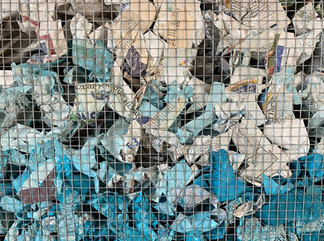

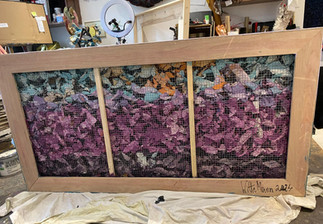











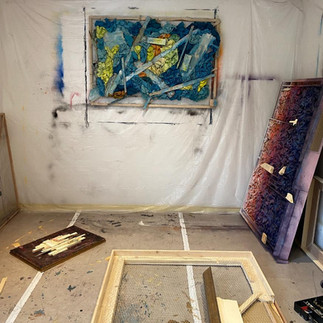







































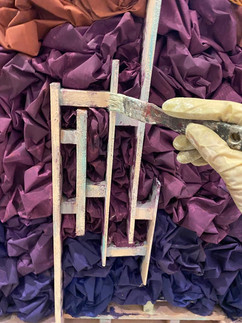

















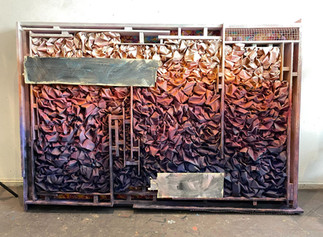
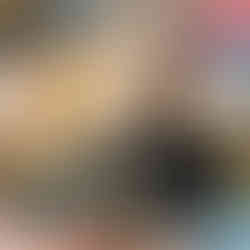


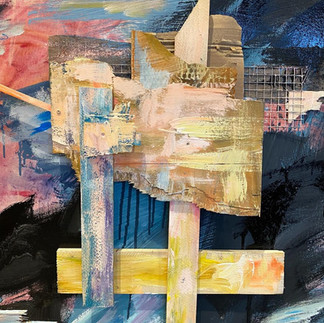






Comentários